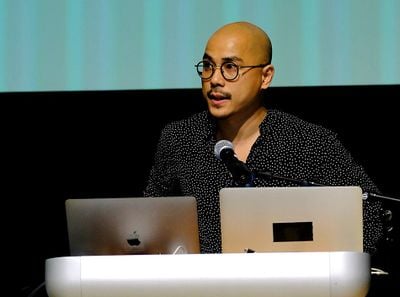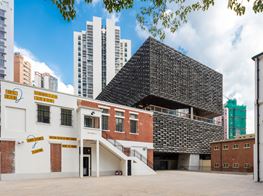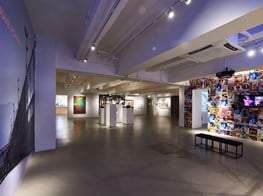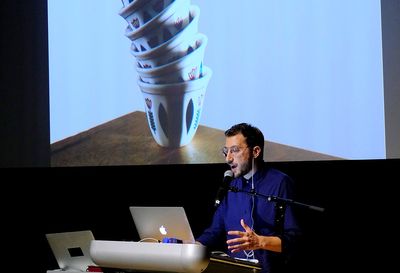Para Site International Conference Diary: Day 3
In collaboration with Para Site
Expanding on the previous two days' themes of heritage, archives and repatriation, the third and final day of Para Site's international conference at Tai Kwun – Centre for Heritage and Arts in Hong Kong began with an eloquent lecture delivered by artist Pio Abad, whose opening sentiments echoed the previous day's discussion by Marian Pastor Roces of political violence and corruption in the Philippines. Abad stated that the constant thread in the Filipino condition—a thread that has transcended colonisers and political leaders—is that of a culture of impunity, and went on to discuss the excavating of silenced histories by examining objects tainted by various authoritarian regimes.

Pio Abad at What to Let Go?, Para Site International Conference, Tai Kwun – Centre for Heritage and Arts, Hong Kong (22–24 November 2018). Courtesy Para Site. Photo: Eddie Lam, Image Art Studio.
In particular, Abad's talk centred around his 2014 solo exhibition Some Are Smarter Than Others at Gasworks in London (12 September–16 November 2014), which was based on an inventory of the collection of Imelda and Ferdinand Marcos. As Abad explained, by the time president Ferdinand Marcos and his wife Imelda were forced out of office in 1986, their ill-gotten wealth was estimated at USD 5–10 billion, and it was only after their ousting that Filipino people finally had access to information about the wealth amassed by the Marcoses. At Gasworks, Abad presented high-definition images and replicas of objects, some of which appeared in a 1991 Christies catalogue and sale of Imelda's former belongings (an auction that served to launder objects of their history). Visitors were encouraged to take postcard images of the works from the show—a gesture meant to symbolise the abstract returning of the objects to the Filipino people, given the impossibility of a more tangible solution. Pointing to the political influence that members of the Marcos family still retain in the Philippines and to the flamboyant despots in power around the world today, Abad asks: did the mythologising of the Marcoses ever really go away?
Following Abad with a lecture titled 'From Object to Feeling: The Festival of Arts, Shiraz-Persepolis as an Archive of Aspirations and Traumas', curator and researcher Vali Mahlouji discussed his work with the non-profit and curatorial platform Archaeology of the Final Decade (AOTFD). In recent years, AOTFD has been engaging with archives of the Festival of Arts, Shiraz-Persepolis, an international avant-garde performing arts festival that took place in Persepolis and Shiraz in Iran from 1967 to 1977. In 1977, the event was declared 'decadent' by officials and was ultimately ended by the advent of the Islamic Revolution; materials related to the event were destroyed or deemed un-Islamic and removed from public access. Mahlouji showed video and photographs from the festival—materials that had been painstakingly pieced together from archives in basements and storage spaces. He emphasised the importance of examining history's blind spots in order to understand the modernities of elsewhere.
Filmmaker and artist Lawrence Abu Hamdan delivered his lecture 'Walled Unwalled' with a literal bang, giving a performative overview of his recent investigations into audio as evidence of the physical logics of noise. Calling himself a 'private ear', Hamdan has long focused on investigating audio evidence in cases of human rights violations and, in particular, designing 'earwitness' interviews that that could solicit and prompt the memories of people present at the time of a crime. At the podium, the artist recorded himself listing 90 or so objects from his recent cases, then replayed the recording as he elaborated on several of them. These included metal stairs (heard by a blindfolded hostage in a Syrian prison), a cricket bat (the cracking noise against a door was pivotal in Oscar Pistorius' murder trial) and a popcorn maker (the sound of which a woman thought she heard before her hotel collapsed into a sinkhole). Fascinatingly, Hamdan pointed out that in his experience, people asked to describe their recollection of violent sounds often use unrelated examples such as the sound of eggs or watermelons smashing as these are objects commonly used to create sound effects for depictions of brutality in film and television.
Next, landscape architecture historian Xiaoxuan Lu and artist and filmmaker Bo Wang delivered a joint talk titled 'Divergent Memories of Tumen Shan-shui' that asked the question, what constitutes heritage: is it necessarily confined to artefacts or can it exist outside the museum? Lu and Wang focused on the political and cultural significance of Mount Baedku and the geographical entities of the Yalu River and the Tumen River—all of which lie on the border of North Korea and China—and their appearances in Chinese, North Korean and South Korean political propaganda and cultural production. The duo presented video case studies of five sites along the Tumen River, with water as a generator of both physical landscapes and conceptual relations within the region.
In the final lecture of the conference, writer and curator Natasha Ginwala discussed her long-term exhibition project Riots: Slow Cancellation of the Future, showing works by John Akomfrah, Glenn Ligon, Satch Hoyt and Chandraguptha Thenuwara, and asserting that for centuries riots have been crucial in the epic refusal of sustained power imbalances arising from colonialism, civil war and genocide.
By the end of three days of rich conversation, it was clear that the majority of speakers were emphatic about cultural pluralism and the unearthing of what has been buried by oppressive regimes. The conference was underscored by a belief that a deep understanding of and close proximity to 'lost' heritage—in the form of forgotten or stolen artefacts, artwork, history or land—can have tangible effects in societies where historical consciousness too often seems to be lacking. —[O]












































































































































































